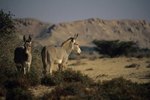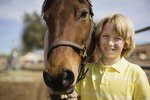
In the equine family, the zebra falls between the horse and the donkey and share some similarities with both. But the zebra has have remained wild while the horse and the donkey are largely domesticated. The zebra remains the most populous of the wild equines and looks likely to remain that way, as both the wild ass and the Przewalski's wild horse are endangered.
Color
The most obvious difference between a horse and a zebra is coloration. Horses come in many colors, and some in patterns with spots and blotches, but all zebras are black-and-white striped. The pattern, natural camouflage, is unique to each individual, as fingerprints are to humans. When the plains zebra (Equus quagga) stands still in the tall grass of the African savanna, his broad vertical striping blends in with the grass stems and renders him almost invisible to a predator. When he's in motion with the herd, fleeing from a lion, all those moving stripes create a wavering, shifting moiré effect and turn each individual into part of one big fuzzy blob, making it hard for a big cat to single out any one zebra from the rest.
Body
Most horses' legs are longer than their bodies are tall, while zebras' legs are about the same length as their body height. This makes the zebra slower than the horse but still fast enough to outdistance a lion over the long haul. His mane and tail are more donkeylike, with the one being stiff and upstanding rather than long and flowing, and the other having a tuft at the end instead of being fully haired from the base.
Feet
Zebra hooves tend to be harder than horse hooves, smaller and more oval in shape, with a wider heel and more open frog. In the mountain zebra' (Equus zebra), the hooves are almost pointed, appropriate for their rocky and more difficult terrain.
Sound
The zebra has a vocabulary of noises equal to those of the horse and the donkey, including the whinny, the bray, the snort and the snuffle; but the zebra also has a unique vocalization called a bark. This is a high-pitched, two-part, almost yipping sound, almost like that of a small dog. It is frequently heard as an alarm call. Uttered when stampeding, it alerts nearby zebras and other grazers like the wildebeests to the presence of a predator. If a family band is separated, it can also be an identification call to make contact with other members.
References
Resources
Photo Credits
-
Anup Shah/Digital Vision/Getty Images



